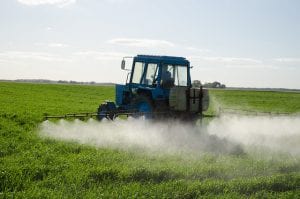The EPA might be facing a deadline. Congressional Democrats recently proposed a reform bill in the Senate that would mark the first comprehensive overhaul of U.S. pesticide rules since 1996.
In October 2020, the Environmental Protection Agency (EPA) extended the use of the toxic pesticide paraquat.
That was despite the agency’s earlier conclusion, that this pesticide poses potential risks to people, wildlife, and the environment. It was a measure that allows the agency to keep the pesticide on the market until 2035.
In this regulatory step, known as an interim decision, the EPA didn’t repudiate its earlier assessment regarding potential public health and ecological impacts. But the agency said that paraquat is still going through the Federal Insecticide, Fungicide, and Rodenticide Act (FIFRA) registration review process.
A group of 52 farm workers, environmental justice, public health, conservation, and farmer advocacy groups submitted a letter in response, urging the EPA to ban paraquat because of its substantial and demonstrated risks. The Michael J. Fox Foundation and the Unified Parkinson’s Advocacy Council, which earlier submitted a petition with 107,000+ community signatures, also continue to fight for a ban.
The EPA says it’s still re-evaluating the chemical. However, the current extension of use for this extremely toxic, old pesticide may cause serious long-term harm to people and wildlife.
The EPA should be banning paraquat. Instead, the agency has steadfastly refused to complete legally required analyses of the pesticide’s impacts on endangered plants and animals.
The Dangers of Paraquat Use
Paraquat has been commercially used since 1964. Most users know it by its trade name, Gramoxone. When many farmers see superweeds develop resistance to glyphosate, commonly sold as Bayer’s Roundup, paraquat is the chemical that they resort to.
That is why the chemical’s use is higher than it’s been in the past 25 years, despite its well-documented harms. Since 2009, its use rose nearly 200%.
However, users have to be certified pesticide applicators who went through specialized training. Because this chemical is the most acutely lethal herbicide still in use today, corrosive to the skin and eyes, that may be inhaled, it’s also transferred onto clothing and will subsequently rub off onto home furniture. So users have to be very careful when handling it.
Paraquat enters the body mainly by swallowing, or through dermal exposure. Once the skin is damaged, paraquat is absorbed into the body.
Paraquat has resulted in the death of at least 50 people in the United States in recent years. One farmer died after just 3.5 hours of spraying diluted paraquat with a leaking knapsack. Others have died from spilling the pesticide on their skin. Thousands more have suffered severe chronic and acute effects from occupational use.
Paraquat and Parkinson’s Disease

A growing body of evidence suggests that exposure to paraquat may very well account for the dramatic rise in the diagnosis of Parkinson’s in recent decades.
Paraquat may cause the onset, or speed up the development, of Parkinson’s Disease. The longer the exposure to the pesticide, the greater the risk. There may be a lag time between exposure and the development of symptoms, and early exposures are the most deleterious.
The unborn fetus and children will be most at risk. Therefore, pregnant women and children should not be exposed to this chemical.
Strong evidence from animal studies that shows paraquat may cause or promote Parkinson’s Disease is supported by many case studies and epidemiological studies linking the two.
In laboratory studies, paraquat has been shown to injure nerve cells and reproduce the features of Parkinson’s disease. In a study in Toxicological Sciences, researchers at the University of Rochester, in New York, exposed mice to paraquat, and the chemical changed males’ sense of smell in a way consistent with the trajectory of Parkinson’s onset. A reduced sense of smell is an early sign of Parkinson’s Disease.
To be sure, data and analyses between people’s exposures and their subsequent risk of developing various ailments, from allergies to cancer, cannot by themselves, prove cause and effect. However, sometimes, such linkages between cause and effect are so strong and the evidence so compelling that there can be little doubt that one causes the other.
According to one study, paraquat can increase the risk of Parkinson’s by 150 percent. Another study in the American Journal of Epidemiology found that paraquat exposure within 500 meters of one’s home increased by 75 percent the risk of Parkinson’s Disease. While a study in Environmental Health Perspectives found that farmers who used paraquat were 2.5 times more likely to have Parkinson’s than those who did not.
Another pioneering study of over 17,000 twin brothers, suggested that environmental factors outranked genetics as a cause of the disease. The authors showed that farmers who used paraquat, among other pesticides, were more than twice as likely to develop Parkinson’s as those who did not use these chemicals.
Although Parkinson’s is common in older adults, its rise has far exceeded the aging of the population. In just 25 years, the prevalence rates for Parkinson’s, increased by 22 percent for the world. Parkinson’s cases are projected to reach 12.9 million by 2040.
Men, who are more likely to work in occupations that expose them to paraquat, have a 40 percent greater risk than women of developing it.
Parkinson’s Disease is progressive, characterized by tremors, slow movements, difficulty walking, and balance problems. It can also cause loss of smell, sleep disorders, and depression. There is as yet no cure, only medications that can alleviate symptoms. People, and their caregivers, can live with gradually worsening symptoms for decades.
Protection Against Paraquat
It’s important to note that the economic burden of Parkinson’s is huge. That is one reason why, currently, agricultural workers and farmers who were exposed to paraquat and, as a result, developed Parkinson’s Disease are filing lawsuits.
One paraquat lawsuit has been filed in 2017 in St. Clair County, Illinois. Plaintiffs in the lawsuit claim that the use of the herbicide Paraquat can cause Parkinson’s Disease. They argue that they were unaware that the chemical posed any long-term health risks.
Paraquat has been banned by 32 countries. Since its ban in the Netherlands years ago, the incidence of Parkinson’s there has declined. Yet, it is still used in the United States.
The EPA might be facing a deadline. Congressional Democrats recently proposed a reform bill in the Senate that would mark the first comprehensive overhaul of U.S. pesticide rules since 1996. The Protect America’s Children from Toxic Pesticides Act would reduce the number and types of toxic chemicals and ban paraquat.
The bill would require the EPA to suspend immediately all pesticides banned in the European Union or Canada, allow local governments to make rules, and empower citizens to petition and sue for review.
The bill would also limit the EPA’s use of emergency exemptions and set up a mandatory national reporting system for injuries and other harm resulting from paraquat, triggering additional scrutiny.


Join the conversation!